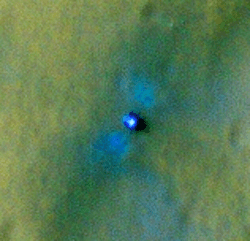Here’s a look down at Curiosity from the HiRISE camera aboard NASA’s Mars Reconnaissance Orbiter, orbiting approximately 200 km (125 miles) above the surface of Mars. This new image, released today, shows the rover inside Gale Crater surrounded by a skirt of blue-tinted material, including several bright radiating marks –the result of the descent stage rockets clearing layers of dust from the surface.
 In this exaggerated-color view the blue indicates material of a different texture and composition than the surrounding area. HiRISE captures images in visible light wavelengths as well as near-infrared, which we can’t see. To us, the blue material would look grey.
In this exaggerated-color view the blue indicates material of a different texture and composition than the surrounding area. HiRISE captures images in visible light wavelengths as well as near-infrared, which we can’t see. To us, the blue material would look grey.
North is up, and Curiosity’s ultimate exploration target, Gale Crater’s central peak, Mount Sharp, is off frame to the lower right.
Click here for a full-size version of the HiRISE image scan, showing the scene above plus some areas further north and south — including portions of the dark dune fields visible in recent images from Curiosity.
It’s nice to know that Curiosity has friends in high places!
Image: NASA/JPL/University of Arizona


Curiosity discovers the source of Louis Blue Otterpop material!
Is the small dark speck to the right of curiosity the skycrane crash site?
No, the Sky Crane crash site is at the 10 o’clock position from Curiosity and out of frame in that picture, but can be seen in this annotated picture.
Thanks for the link to the other photo!
Hmm just an outcropping of rock then? I wonder if they have any plans get a good look at it. Although i am no geologist and it’s probably interesting than it seems…
So far I hear immediate plans to look at the exposed bedrock, and secondary plans to go to the intersection of the three different areas you see in the image. The latter is because they can use that area to sort out the basement, here bedrock, position vs other layers.
The upper light brown area is the edge of the large alluvial fan that covers much of north Gale crater. That is interesting in itself, since it can have trapped and transported recent organics, as well as have exposed rocks that have been modified by any extant life.
[Seems they licked the longstanding problem of “desert varnish” that already Darwin worked on just in time for this. It is pretty much constrained to be microbial action by a recent paper, its growth rates in best conditions is beyond other weathering. So rock surfaces can tell of life. Not that I personally think extant life survives on martian surfaces. But at least it should be excluded.]
The lightly cratered area where Curiosity landed has a younger surface for whatever reason, and the more cratered area just visible at the right corner of the image has an older surface.
The latter travel plans takes it almost in opposite directions of your outcrop. On the other hand there seems to be a larger one that they pass on the way.
The distance is ~ 600 m IIRC, which would take a couple of weeks. I hear they estimate travel over the Aeolis Palus, the IAU name for the norther plane, and arrival at Aeolis Mons, the IAU name for the mountain, in ~ 1 tellusian year.
So maybe they won’t take too many side trips while traveling. If you look at the HiRISE latest pass over Curiosity, the Mons foothills looks positively barred by sand dunes. They will have to work around a lot of potential rover traps as they go, hopefully they have options outside the image pass. (They should, I hear some handful of possible routes have been suggested already.)
Very interesting, thank you for the reply.
I guess we may never find out what it really is…
😉
http://www.nerdragecomic.com/images/ancientaliens.jpg
Whenever I see this guy on the tube… I change the channel. Read: Bunk science..
Except that I confused your outcrop with the one that following IVAN3MANs direction gave.
Your’s is the one in the general direction they may take. Maybe they will take a look then.
Interesting … so this section of Mars is actually “bluish” (or some other color) underneath a coating of red dust? Or is this an enhancement for clarity?
No to our eyes it would like grey.
Most of Mars bedrock is basalt, not much of plate tectonics reworking it to our granites. Fresh basalt surfaces vary from black to gray, if that is what we are looking at.
[But can look blue tinted depending on light conditions FWIW; this is not what this enhanced wide spectral image shows.]
Curiosity’s new bed rocks!